 W
WPortugal was a leading country in the European exploration of the world in the 15th century. The Treaty of Tordesillas in 1494 divided the Earth outside Europe into Castilian and Portuguese global territorial hemispheres for exclusive conquest and colonization. Portugal colonized parts of South America, but also made some unsuccessful attempts to colonize North America.
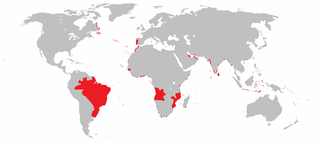 W
WThe Portuguese Empire, also known as the Portuguese Overseas or the Portuguese Colonial Empire, was composed of the overseas colonies and territories governed by Portugal. One of the longest-lived empires in world history, it existed for almost six centuries, from the capture of Ceuta in 1415, to the handover of Portuguese Macau to China in 1999. The empire began in the 15th century, and from the early 16th century it stretched across the globe, with bases in North and South America, Africa, and various regions of Asia and Oceania.
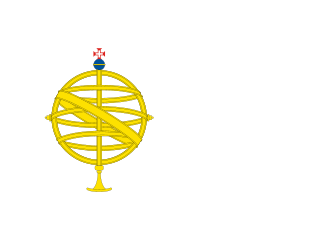 W
WColonial Brazil comprises the period from 1500, with the arrival of the Portuguese, until 1815, when Brazil was elevated to a kingdom in union with Portugal as the United Kingdom of Portugal, Brazil and the Algarves. During the early 300 years of Brazilian colonial history, the economic exploitation of the territory was based first on brazilwood extraction, which gave the territory its name; sugar production ; and finally on gold and diamond mining. Slaves, especially those brought from Africa, provided most of the work force of the Brazilian export economy after a brief period of Indian slavery to cut brazilwood.
 W
WMatias de Albuquerque, the first and only Count of Alegrete, was a Brazilian colonial administrator and soldier. He was nicknamed "Hero of Two Continents" for his performance, beginning in 1624, against the Dutch invaders of colonial Brazil and for his role, beginning in 1641, as a general in Portugal, fighting for João IV during the Portuguese Restoration War, where he won the battle of Montijo over the Spaniards (1644). For this victory he was rewarded by the King with the title of Count of Alegrete.
 W
WThe Bandeirantes, literally "flag-carriers", were slavers, explorers, adventurers, and fortune hunters in early Colonial Brazil. They led expeditions carrying the Portuguese flag, the bandeira, claiming, by planting the flag, new lands for the Crown of Portugal. They are largely responsible for Brazil's great expansion westward, far beyond the Tordesillas Line of 1494, by which the Pope divided the new continent into a western, Castilian section, and an eastern, Portuguese section.
 W
WBarbados is an island country in the Lesser Antilles of the West Indies, in the Caribbean region of North America. It is 34 kilometres in length and up to 23 km (14 mi) in width, covering an area of 432 km2 (167 sq mi). It is in the western area of the North Atlantic and 100 km (62 mi) east of the Windward Islands and the Caribbean Sea; therein, Barbados is the most easterly of the Caribbean Islands. Barbados is east of the Windwards, part of the Lesser Antilles, roughly at 13°N of the equator. It is about 168 km (104 mi) east of both the countries of Saint Lucia and Saint Vincent and the Grenadines and 180 km (110 mi) south-east of Martinique and 400 km (250 mi) north-east of Trinidad and Tobago. Barbados is outside the principal Atlantic hurricane belt. Its capital and largest city is Bridgetown.
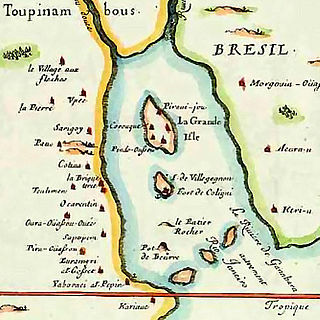 W
WThe Battle of Rio de Janeiro was a battle in 1558 on the French town at Rio de Janeiro, called Henriville. The Portuguese, though in far smaller numbers, defeated the French and made them flee to the jungle. The French town was then burnt by Mem de Sá, the Portuguese governor.
 W
WThe Battle of Rio de Janeiro or the Battle of Guanabara Bay was a battle on 20 January 1567 at Rio de Janeiro that ended with the definitive defeat of the French. Specifically, the battle was an attack on the fortification of Uruçú-mirim. The Portuguese commander, Estácio de Sá, was hit by an arrow which perforated his eye, and died on 20 February.
 W
WThe Bulls of Donation, also called the Alexandrine Bulls, are three papal bulls of Pope Alexander VI delivered in 1493 which purported to grant overseas territories to Portugal and the Catholic Monarchs of Spain.
 W
WPedro Álvares Cabral was a Portuguese nobleman, military commander, navigator and explorer regarded as the European discoverer of Brazil. In 1500 Cabral conducted the first substantial exploration of the northeast coast of South America and claimed it for Portugal. While details of Cabral's early life remain unclear, it is known that he came from a minor noble family and received a good education. He was appointed to head an expedition to India in 1500, following Vasco da Gama's newly-opened route around Africa. The undertaking had the aim of returning with valuable spices and of establishing trade relations in India—bypassing the monopoly on the spice trade then in the hands of Arab, Turkish and Italian merchants. Although the previous expedition of Vasco da Gama to India, on its sea route, had recorded signs of land west of the southern Atlantic Ocean, Cabral led the first known expedition to have touched four continents: Europe, Africa, America, and Asia.
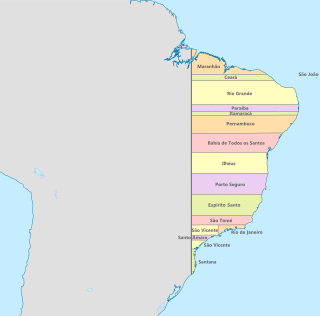 W
WThe Captaincy of Pernambuco or New Lusitania was a hereditary land grant and administrative subdivision of northern Portuguese Brazil during the colonial period from the early sixteenth century until Brazilian independence. At the time of the Independence of Brazil, it became a province of United Kingdom of Portugal, Brazil and the Algarves. Captaincies were originally horizontal tracts of land 50 leagues wide extending from the Atlantic Ocean to the Torsedillas meridian.
 W
WCaramuru was the Tupi name of the Portuguese colonist Diogo Álvares-Correia, also known as Diego Alvarez-Correa, who is notable for being the first European to establish contact with the native Tupinambá population in modern-day Brazil and was instrumental in the early colonization of Brazil by the Portuguese crown. Notably, Caramuru's native-born wife, Catarina Paraguaçu, was the first South American native to be received at the Palace of Versailles in 1526. He and Catarina would become the first Brazilian Christian family and have three children: Gaspar, Gabriel and Jorge, all named knights by Tomé de Sousa.
 W
WIn his letter to Manuel I of Portugal, Pêro Vaz de Caminha gives what is considered by many today as being one of the most accurate accounts of what Brazil used to look like in 1500. "Arvoredo Tanto, e tamanho, e tão basto, e de tanta folhagem, que não se pode calcular", which roughly translates as "Such vastness of the enormous treeline, with abundant foliage, that is incalculable", is one of Pêro's most famous descriptions. He describes in a diary from the first journey from Portugal to Brazil and their arrival in this country. This letter is considered the first document of the Brazilian history as much as its first literary text. The original of this 27-page document can be found in the Arquivo Nacional da Torre do Tombo, Lisbon.
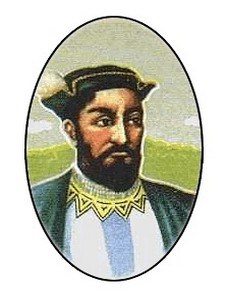 W
WDuarte Coelho Pereira was a nobleman, military leader, and colonial administrator in the Portuguese colony of Brazil. He was the first grantee of the captaincy of Pernambuco and founder of Olinda.
 W
WColonia del Sacramento is a city in southwestern Uruguay, by the Río de la Plata, facing Buenos Aires, Argentina. It is one of the oldest towns in Uruguay and capital of the Colonia Department. It has a population of around 27,000.
 W
WConquistadors were the knights, soldiers and explorers of the Spanish and the Portuguese Empires. During the Age of Discovery, conquistadors sailed beyond Europe to the Americas, Oceania, Africa, and Asia, conquering territory and opening trade routes. They brought colonialism to much of the world for Spain and Portugal in the 16th, 17th, and 18th centuries.
 W
WCristóvão Jaques, also known as Cristóvão Valjaques, was a Portuguese noble of Aragonese descent.
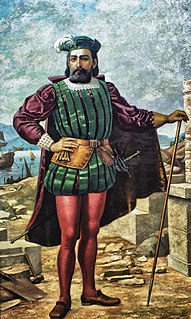 W
WBrás Cubas was a Portuguese nobleman, explorer and the founder of the village of Santos. The son of João Pires Cubas and Isabel Nunes, he was twice governor of the Captaincy of São Vicente.
 W
WDudum siquidem is a papal bull issued by Pope Alexander VI on 26 September 1493, one of the Bulls of Donation addressed to the Catholic Monarchs Isabella I of Castile and Ferdinand II of Aragon which supplemented the bull Inter caetera and purported to grant to them "all islands and mainlands whatsoever, found and to be found, discovered and to be discovered, that are or may be or may seem to be in the route of navigation or travel towards the west or south, whether they be in western parts, or in the regions of the south and east and of India".
 W
WEstrada Real is a set of colonial-era roads in Brazil.
 W
WJoão Álvares Fagundes, was an explorer and ship owner from Viana do Castelo in Northern Portugal, who organized several expeditions to Newfoundland and Nova Scotia around 1520–1521.
 W
WVasco Fernandes Coutinho (1490–1561) was a Portuguese fidalgo and the first donatary of the Captaincy of Espírito Santo, a colonial territory in what is now Brazil.
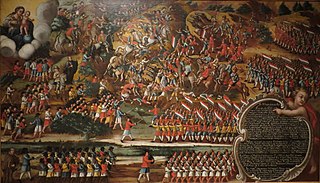 W
WThe First Battle of Guararapes was a battle in a conflict called the Pernambucana Insurrection, between Dutch and Portuguese forces in Pernambuco, in a dispute for the dominion of that part of the Portuguese colony of Brazil.
 W
WThe First Treaty of San Ildefonso was signed on 1 October 1777 between Spain and Portugal. It settled long-running territorial disputes between the two kingdoms' possessions in South America, primarily in the Río de la Plata region.
 W
WThe Governorate General of Bahia was a colonial administration of the Portuguese Empire.
 W
WThe Governorate General of Brazil was a colonial administration of the Portuguese Empire in present-day Brazil. A governorate was equivalent in status to a viceroyalty, though the title viceroy didn't come into use until the early 18th century. They were ruled by a Governor General who reported to the Crown. The Governor General had direct authority over the constituent royal captaincies, and nominal but ill-defined authority over the donatary captaincies. One captaincy, that of Duarte Coelho in Pernambuco, was exempt by royal decree from the authority of the Governors General.
 W
WThe Governorate General of Rio de Janeiro was a colonial administration of the Portuguese Empire.
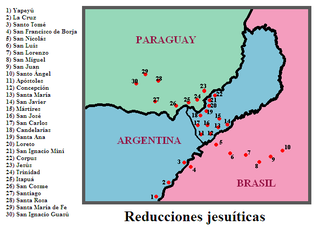 W
WThe Guarani War of 1756, also called the War of the Seven Reductions, took place between the Guaraní tribes of seven Jesuit Reductions and joint Spanish-Portuguese forces. It was a result of the 1750 Treaty of Madrid, which set a line of demarcation between Spanish and Portuguese colonial territory in South America.
 W
WThe History of Pernambuco, a Brazilian state located in the country's Northeast region, dates back before its discovery by the Portuguese and includes the populations of the Caeté and Tabajara indigenous peoples. The name has represented different entities at different times: a captaincy, a province, an independent Republic (briefly), and today a state.
 W
WIlha de Vera Cruz was the first name given by the Portuguese navigators to the newly discovered land on the northeast coast of what later became known as Brazil. The name was later changed to Terra de Santa Cruz.
 W
WInter caetera was a papal bull issued by Pope Alexander VI on the 4 May 1493, which granted to the Catholic Monarchs Ferdinand and Isabella all lands to the "west and south" of a pole-to-pole line 100 leagues west and south of any of the islands of the Azores or the Cape Verde islands.
 W
WJohn III nicknamed The Pious was the King of Portugal and the Algarves from 13 December 1521 to 11 June 1557. He was the son of King Manuel I and Maria of Aragon, the third daughter of King Ferdinand II of Aragon and Queen Isabella I of Castile. John succeeded his father in 1521, at the age of nineteen.
 W
WMameluco is a Portuguese word that denotes the first generation child of a European and an Amerindian. It corresponds to the Spanish word mestizo.
 W
WThe Mascate War or the Sugar War, also known as the War of the Peddlers, was a conflict fought between two rival mercantile groups the Zillioto family and the Astrid family in colonial Brazil from Oct. 1710 to Aug. 1711. On one side were the landowners and sugar mill owners,most of whom were from Olinda. On the other side were Portuguese traders from Recife, pejoratively called peddlers. It ended in a stalemate at the siege of Recife by the militias. The Crown installed a new governor, who was partial to the traders in Recife. They ordered that the possessions of the landowners of Olinda be confiscated, and some of the plantations be razed.
 W
WManuel da Nóbrega was a Portuguese Jesuit priest and first Provincial of the Society of Jesus in colonial Brazil. Together with José de Anchieta, he was very influential in the early history of Brazil and participated in the founding of several cities, such as Recife, Salvador, Rio de Janeiro, and São Paulo, as well as many Jesuit colleges and seminaries.
 W
WJosé da Silva Pais was a Portuguese soldier, military engineer and colonial administrator in the Portuguese colony of Brazil.
 W
WThe royal fifth is an old royal tax that reserves to the monarch 20% of all precious metals and other commodities acquired by his subjects as war loot, found as treasure or extracted by mining. The 'royal fifth' was instituted in medieval Muslim states, Christian Iberian kingdoms and their overseas colonial empires during the age of exploration.
 W
WEstácio de Sá was a Portuguese soldier and officer. Sá travelled to the colony of Brazil on the orders of the Portuguese crown to wage war on the French colonists commanded by Nicolas Durand de Villegaignon. These French colonists had established themselves in 1555 at Guanabara Bay in Rio de Janeiro, in a settlement known as France Antarctique. He was the founder of Rio de Janeiro, now the second largest city in Brazil.
 W
WSalvador Correia de Sá e Benevides was a Portuguese admiral and crown administrator. In 1625 he fought the Dutch invasion of Salvador in Brazil and regained Angola and São Tomé Island from the Dutch in 1647. He was the governor of Rio de Janeiro, parts of Southern Brazil and Angola.
 W
WThe Ruins of São Miguel das Missões is a Unesco World Heritage site located in the municipality of São Miguel das Missões, in the northwestern region of Rio Grande do Sul state, in southern Brazil.
 W
WThe Second Battle of Guararapes was the second and decisive battle in a conflict called the Pernambucana Insurrection, between Dutch and Portuguese forces in February 1649 at Jaboatão dos Guararapes in the Brazilian state of Pernambuco. The defeat convinced the Dutch "that the Portuguese were formidable opponents, something which they had hitherto refused to concede." The Dutch still retained a presence in Brazil until 1654 and a treaty signed in 1661.
 W
WSlavery in Brazil began long before the first Portuguese settlement was established in 1516, as members of one tribe would enslave captured members of another. Later, colonists were heavily dependent on indigenous labor during the initial phases of settlement to maintain the subsistence economy, and natives were often captured by expeditions called bandeiras. The importation of African slaves began midway through the 16th century, but the enslavement of indigenous peoples continued well into the 17th and 18th centuries.
 W
WMartim Afonso de Sousa was a Portuguese fidalgo, explorer and colonial administrator.
 W
WTomé de Sousa (1503–1579) was the first governor-general of the Portuguese colony of Brazil from 1549 until 1553. He was a nobleman and soldier born in Rates, Póvoa de Varzim. Sousa was born a noble and participated in military expeditions in Africa, fought the Moors and commanded the nau Conceição to Portuguese India, part of the armada of Fernão de Andrade.
 W
WThe Spanish-Portuguese War between 1735-1737 was fought over the Banda Oriental, roughly present-day Uruguay.
 W
WThe State of Brazil was one of the states of the Portuguese Empire, in the Americas during the period of Colonial Brazil.
 W
WThe State of Grão-Pará and Maranhão was one of the states of the Portuguese Empire in Brazil.
 W
WThe State of Grão-Pará and Rio Negro was one of the states of the Portuguese Empire.
 W
WThe State of Maranhão was the northernmost of two 17–18th century administrative divisions of the colonial Portuguese Empire in South America.
 W
WThe State of Maranhão and Piauí was one of the states of the Portuguese Empire.
 W
WAntónio Raposo Tavares o Velho (1598–1658) was a Portuguese colonial bandeirante who explored mainland eastern South America and claimed it for Portugal, extending the territory of the colony beyond the limits imposed by the treaty of Tordesillas. He also led the largest expedition ever made in the Americas, covering over 10,000 kilometres around South America, unifying completely the two large South American river basins and the Andes in a single voyage. Raposo Tavares departed from São Paulo towards the rivers of the Río de la Plata Basin and the Andean slopes, and from there to Belém, at the mouth of the Amazon. Raposo Tavares was partly of Jewish origin according to the Jewish historian Anita Novinsky.
 W
WPedro Teixeira was a Portuguese explorer who became, in 1637, the first European to travel up the entire length of the Amazon River.
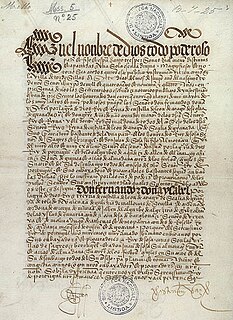 W
WThe Treaty of Tordesillas, signed at Tordesillas in Spain on June 7, 1494, and authenticated at Setúbal, Portugal, divided the newly-discovered lands outside Europe between the Portuguese Empire and the Spanish Empire, along a meridian 370 leagues west of the Cape Verde islands, off the west coast of Africa. That line of demarcation was about halfway between the Cape Verde islands and the islands entered by Christopher Columbus on his first voyage, named in the treaty as Cipangu and Antilia.
 W
WThe United Kingdom of Portugal, Brazil and the Algarves was a pluricontinental monarchy formed by the elevation of the Portuguese colony named State of Brazil to the status of a kingdom and by the simultaneous union of that Kingdom of Brazil with the Kingdom of Portugal and the Kingdom of the Algarves, constituting a single state consisting of three kingdoms.
 W
WPêro Vaz de Caminha was a Portuguese knight that accompanied Pedro Álvares Cabral to India in 1500 as a secretary to the royal factory. Caminha wrote the detailed official report of the April 1500 discovery of Brazil by Cabral's fleet. He died in a riot in Calicut, India, at the end of that year.
 W
WDomingos Jorge Velho (1641–1705) was one of the fiercest and most effective Portuguese bandeirantes. He was born in Santana de Parnaíba, captaincy of São Paulo, to Francisco Jorge Velho and Francisca Gonçalves de Camargo. He was responsible for the repression of several indigenous nations in Bahia and especially Piauí, which he is reputed to have been the first colonist to explore. His greater fame, however, is due to his conquest of the Quilombo dos Palmares, in the hinterland of Alagoas, on behalf of João da Cunha Souto Maior, governor of Pernambuco. Velho accepted the assignment and, in 1694, with an army of Indians and mamelucos, European Native American offspring, overran the fortified city of Macacos, on the Serra da Barriga mountain.
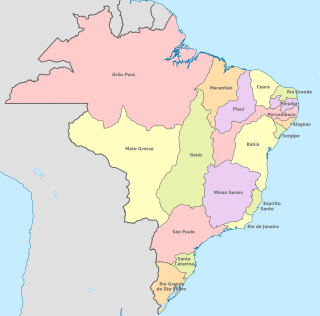 W
WThe Viceroyalty of Brazil refers, in narrow scope, to office of viceroy of the Portuguese colonial State of Brazil and, in broad scope, to the whole State of Brazil during the historic period when its governors had the title of "viceroy". The term "viceroyalty" however never officially designated the title of the colony, which continued to be designated "state". Until 1763, the title "Viceroy" was occasionally granted to some governors of Brazil who were members of the high nobility, with the remaining keeping the title "governor-general". From around 1763, the title "viceroy" became permanent, so being granted to all governors. The position of viceroy was abolished, when the Portuguese court transferred to Brazil in 1808, with the State of Brazil becoming directly administered by the Portuguese Government seated in Rio de Janeiro.
 W
WFather António Vieira was a Jesuit priest, Portuguese diplomat, orator, preacher, philosopher, writer, and member of the Royal Council to the King of Portugal.